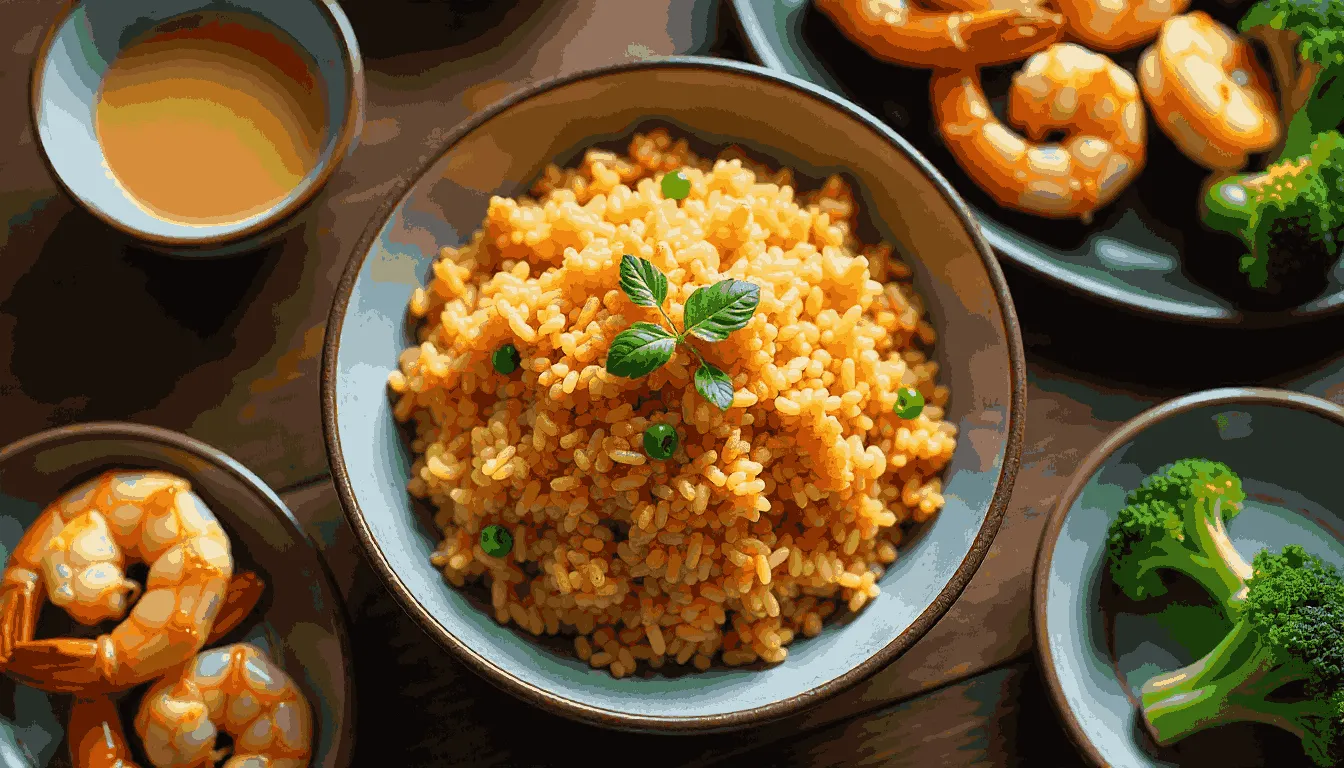That sizzling sound. The flashing knife skills. That incredible, savory aroma that hits you the moment you walk into a Japanese steakhouse. But for many of us, the star of the show isn’t the steak or the shrimp; it is that irresistible pile of golden, flavorful fried rice. But what if you could recreate that magic in your kitchen? The good news: You absolutely can. Perfecting a true hibachi fried rice recipe is not about secret ingredients; it’s about a few simple non-negotiable techniques. This is not just leftover rice with soy sauce-this is a dish with distinct, separate grains, with deep savory flavor and that iconic yellow hue. Forget needing a giant teppanyaki grill. With the right prep and a hot skillet, you can turn your kitchen into the best seat in the house. Let’s unlock the secrets together.
The Foundation: Why Your Rice Choice Makes All the Difference
Every great building needs a solid foundation, and for fried rice, that is the rice itself. The single most important step to a perfect hibachi fried rice recipe actually happens long before you turn on the stove.
You must use day-old, cold rice.
This is not a suggestion-it’s the golden rule. Freshly cooked rice is steamy and hydrated, making it soft and sticky. When you try to fry it, you’ll end up with a gummy, clumpy mess. Rice that’s spent a night in the fridge, however, dries out just enough. Its grains firm up, ensuring they remain separate and reach that perfect, slightly chewy texture when they hit the hot oil.
What kind of rice works best? The classic choice is medium or long-grain white rice, such as Jasmine rice. It has a less intrusive aroma and is less sticky than its short-grain counterpart. The starch retrogradation process, described in the Journal of Food Science, will detail how cooling cooked rice causes starch molecules to reorganize into firm, separated grains. This is the science that justified our day-old rice rule.
*Pro Tip: If you’re in a pinch, you can speed up the process. Spread your freshly cooked rice in a thin layer on a baking sheet and pop it in the freezer for 20-30 minutes. It works in a crunch!*
Gathering Your Ingredients: The Hibachi Flavor Profile
Amazingly, the ingredient list for a classic hibachi fried rice recipe is quite simple. The magic is in the combination and the technique. Everything being prepped and within arm’s reach (the practice known as mise en place) is crucial because the cooking process is fast.
The Main Cast:
- 3 cups of day-old, cold white rice
- 2 tablespoons of neutral oil (avocado or canola work well)
- 1 tablespoon of toasted sesame oil
- 2 large eggs, lightly beaten
- 1 small yellow onion, finely diced
- 2-3 tablespoons of soy sauce (use tamari for gluten-free)
- 1 tablespoon of butter (this is the secret for richness)
- 2-3 scallions, thinly sliced
The Flavor Enhancers (Optional but Recommended):
- 1/2 cup of frozen peas and carrots, thawed
- 1 teaspoon of minced garlic
- A pinch of white pepper

Your Step-by-Step Hibachi Fried Rice Recipe
Ready to cook? Follow these steps closely for that authentic steakhouse result.
Step 1: The High-Heat Scramble
Place a large skillet or wok over medium-high heat and let it get properly hot. Add one tablespoon of neutral oil. Once the oil shimmers, pour in your beaten eggs. Scramble them quickly, breaking them up into small, bite-sized pieces. Once they’re just cooked through, remove them from the skillet and set them aside on a plate.
Step 2: Sautéing the Aromatics
Add the remaining tablespoon of neutral oil to the hot skillet. Toss in your diced onion (and frozen veggies, if using). Stir-fry for 2-3 minutes until the onion becomes translucent and fragrant. If you’re using garlic, add it now and cook for just 30 seconds more until you can smell its aroma.
Step 3: The Main Event: Frying the Rice
Now, add your cold, day-old rice to the skillet. Break up any large clumps with your fingers or a spatula as you add it. Pro tip: do not stir immediately. Let the rice sit for about 30-45 seconds to get a slight crisp on the bottom, then start tossing and stir-frying to coat every grain in the oil.
Step 4: Building the Layers of Flavor
Push the rice to one side of the skillet. Add the tablespoon of butter to the empty space. Let it melt and foam slightly. Now, drizzle the soy sauce directly onto the melted butter. This technique allows the soy sauce to caramelize slightly, deepening its flavor before you mix it into the rice.
Add the scrambled eggs back in, along with your sliced scallions. Now, toss everything together vigorously until it’s perfectly combined.
Step 5: The Finishing Touch
Remove the skillet from the heat. Drizzle the tablespoon of toasted sesame oil over the top and give it one final toss. The residual heat will bloom the sesame oil’s flavor without burning it, giving your rice that authentic, nutty finish.
Taste and adjust if needed, sometimes a tiny extra splash of soy sauce is perfect.

Pro Tips for the Absolute Best Results
- Don’t Skimp on Heat: Your pan needs to be hot to create that characteristic “wok hei” or breath of the wok, which is the slightly smoky, seared flavor. If your pan isn’t hot enough, the rice will steam and become mushy.
- The Butter is Key: Many home cooks skip the butter, but it’s what gives Japanese steakhouse fried rice its distinctive, rich flavor that sets it apart from other fried rice varieties.
- Customize It: This hibachi fried rice recipe is a perfect base. Feel free to add in diced chicken, shrimp, or steak that you’ve cooked separately. Just make sure any added proteins are cooked and cooled before you stir them in at the end with the eggs.
- The Blackstone Griddle Method: If you are using a Blackstone griddle, the process is identical and arguably even better. The large, flat cooking surface mimics a teppanyaki grill perfectly. Just cook each component in its own zone and then combine everything in the center.
The Final Sizzle: Your Kitchen, Your Steakhouse
There you have it. The mystery of that perfect hibachi fried rice recipe is solved. It’s a dish that proves incredible flavor doesn’t have to be complicated. It’s about the crisp texture of day-old rice, the savory depth of caramelized soy sauce, and the rich finish of butter and sesame oil. This is more than just a side dish; it’s the centerpiece of a memorable meal you created yourself. So, fire up that skillet, grab your spatula, and get ready for the best part, the look on everyone’s face when they take that first, unforgettable bite.
Frequently Asked Questions (FAQ Section)
1. Can I use freshly cooked rice for hibachi fried rice?
It is highly not recommended. Fresh rice contains too much moisture and will result in a sticky, clumpy, and mushy fried rice. Using day-old, cold rice is the most critical step for achieving the correct texture.
2. What’s the difference between hibachi fried rice and regular fried rice?
Hibachi fried rice is a style of Japanese fried rice typically cooked on a flat-top teppan grill. It’s characterized by its simple flavor profile (soy sauce, butter, sesame oil), its yellow color from the egg yolk, and its distinct, slightly smoky flavor from high-heat cooking.
3. Why is my fried rice soggy?
Soggy fried rice is almost always caused by one of two things: using warm, fresh rice that is too moist, or overcrowding the pan, which causes the ingredients to steam instead of fry.
4. Can I make this recipe gluten-free?
Absolutely. Simply substitute the regular soy sauce for tamari or a certified gluten-free soy sauce. All other core ingredients are naturally gluten-free.
5. What can I use instead of soy sauce?
For a different flavor profile, you can use coconut aminos, which is slightly sweeter and less salty. If you need to avoid soy entirely, a pinch of sea salt combined with an extra teaspoon of butter can work in a pinch, though the flavor will be less classic.
All images are generated by Freepik.










Leave a Reply